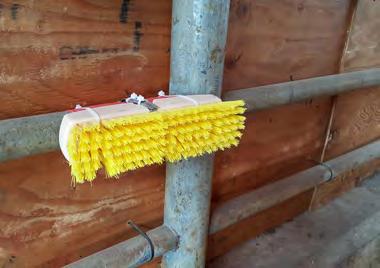
4 minute read
Cow brushes
from December 2021
by MilkProducer
COW BRUSHES – A USEFUL TOOL
How offering a range of brush types can benefit your growing heifers
By Marina von Keyserlingk and Dan Weary CONTRIBUTORS
Brushes, both automated and fixed, are becoming more common on dairy farms. Along with providing comfort, they allow cows to express natural grooming behaviours. Previous work by University of British Columbia (UBC) researchers shows just how important these brushes are to cow health. Essentially, cows will use just enough force to access a brush as they would to access fresh feed. On some farms, calves and growing heifers are also provided access to brushes (typically fixed brushes as illustrated in Figure 1A). To date, the benefits of providing young stock with access to grooming devices is not as well studied.
STUDY EXAMINES COW BEHAVIOUR
A recent study at UBC’s Dairy Education and Research Centre by members of the animal welfare program helps understand how weaned heifers use these brushes, providing a scientific basis for recommended best practices for dairy farmers. Researchers assessed heifer preferences for brush orientation, bristle stiffness and brush location within the pen. The changes in brush use over time was also measured, as was how the cows responded to the brush being removed for a short period of time and then later returned.
For the first phase of the study, 13 groups were formed, each consisting of four weaned Holstein heifers averaging 146 days of age and initially unfamiliar with brushes. They were housed in an open-bedded pen that provided access to four brushes attached to walls, with two brushes providing moderately stiff bristles and the other two with very stiff bristles. For each bristle type, one brush was placed vertically and one horizontally. The time heifers spent interacting with the brushes was recorded over a one-week period.
For the second phase of the study, the heifers were moved in pairs to a freestall pen (shown in Figure 1B) with two treatments applied (13 pairs of heifers were tested for each treatment). For the first five days of this second phase, a stiff brush was attached inside each freestall (the brush treatment as illustrated in Figure 1B) and no brushes were provided to the

WALL-MOUNTED SCRUB brush (Figure 1A on left) and stall-mounted scrub brushes (Figure 1B) are provided to heifers. Brush dimensions: 25.4 by 6.0 centimetres, 3.8 cm long bristles. From Van Os et al. (2021). J. Dairy Sci. 104:12019-12029.
control treatment. After five days, a brush was added to stalls in the control pen to allow the researchers to assess the effect of a short period of brush deprivation.
Brush use was highest after heifers were first introduced to the brushes, with animals using the brushes for 46 minutes per day on average. Brush use decreased but then remained relatively consistent throughout the first phase of the study. Heifers primarily used the brushes for grooming, 60 per cent of which mostly groomed their head. The remainder of the time the cows interacted with the brushes was spent licking, sucking and chewing the bristles and body. Heifers spent similar amounts of time interacting with the brushes regardless of brush orientation or bristle type.
In phase 2 of the study, when heifers were moved to freestall pens, brushes were primarily used for oral manipulation. Heifers in the brush treatment did not change the time spent interacting with the brushes over the six-day testing period. However, the control heifers that were deprived of the brushes for the first five days of the study showed more brush use, such as oral and grooming behaviour, on day six compared with the heifers who had continuous access to the brush. This rebound effect suggests brushes are important to dairy heifers.
IN CONCLUSION
The results of this study indicate brushes are used by dairy heifers for both grooming and oral manipulation. Heifers in this study did not appear to discriminate between brush types or brush orientation, suggesting heifers can benefit from a range of brush types and installations.
The results described in this article are based on Van Os J.M.C, S.A. Goldstein, D.M. Weary, M.A.G von Keyserlingk. Stationary brush use in naïve dairy heifers. 2021. J. Dairy Sci. 104:12019-12029. General funding for the Animal Welfare Program during the time of this study was provided by the NSERC Industrial Research Chair program, with industry contributions from the Alberta Milk, British Columbia Dairy Association, Boehringer Ingelheim, Lactanet, BC Cattle Industry Development Fund, Dairy Farmers of Canada, Dairy Farmers of Manitoba, Intervet Canada Corporation, Saputo Inc., SaskMilk and Semex Alliance.
Reference: From Van Os et al. (2021). J. Dairy Sci. 104:12019-12029.
Marina von Keyserlingk
is a professor in the animal welfare program in the faculty of land and food systems at the University of British Columbia and a Natural Sciences and Engineering Research Council of Canada Industrial Research Chair in animal welfare.
Daniel Weary
is a professor in the animal welfare program in the faculty of land and food systems at the University of British Columbia and a Natural Sciences and Engineering Research Council of Canada Industrial Research Chair in animal welfare.










